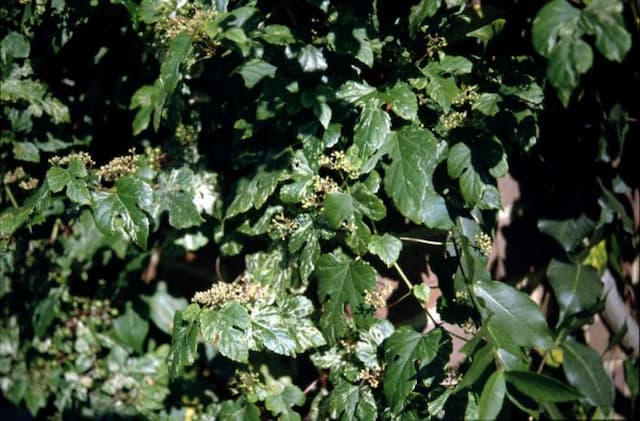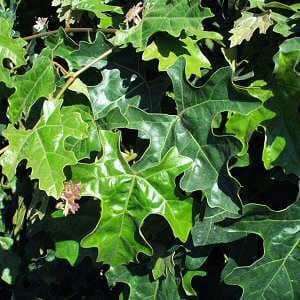Virginia Creeper Parthenocissus quinquefolia

ABOUT
The common name for Parthenocissus quinquefolia is Virginia creeper. It is a climbing vine known for its ability to cover surfaces such as walls, fences, and tree trunks. The vine attaches to surfaces using small, forked tendrils tipped with adhesive pads, enabling it to climb and secure itself tightly. Virginia creeper is easily identified by its leaves, which are usually grouped in clusters of five leaflets. Each leaflet is oval to egg-shaped with toothed edges and a pointed tip. The leaves are generally a shiny green color during the growing season, transitioning to vibrant shades of red and purple in the fall, providing seasonal interest and color in the landscape. The plant also produces small, inconspicuous greenish flowers. These flowers are not particularly showy, but they give way to attractive, bluish-black berries that are a food source for birds and wildlife. The berries are typically about 1/4 to 1/3 of an inch in diameter and may be seen adorning the vine in summer and into the fall. Virginia creeper's bark is brownish-gray and, on older stems, may appear somewhat woody and rough. New growth stems exhibit a green to reddish color. This plant's appearance can vary greatly depending on the environment it grows in, but its ability to climb and the distinctive five-leaflet arrangement of its foliage make it recognizable in many different settings.
About this plant
 Names
NamesFamily
Vitaceae.
Synonyms
Virginia Creeper, American Ivy, Woodbine, Five-Leaved Ivy, Five-Finger, Engleman's Ivy.
Common names
Ampelopsis quinquefolia, Cissus hederacea, Cissus quinquefolia, Hedera quinquefolia, Parthenocissus hirsuta, Parthenocissus inserta, Psedera quinquefolia, Vitis quinquefolia, Vitis inserta, Vitis hirsuta.
 Toxicity
ToxicityTo humans
Virginia creeper is not considered highly toxic to humans, but its berries and leaves can cause stomach upset if ingested in large quantities. Symptoms of ingestion can include vomiting, diarrhea, and abdominal pain. It is generally recommended to avoid consuming any part of this plant.
To pets
Virginia creeper is also not highly toxic to pets, but it can cause similar symptoms as in humans if ingested. Pets might experience vomiting, diarrhea, and abdominal pain after consumption. As with humans, it is advisable to prevent pets from ingesting parts of the plant.
 Characteristics
CharacteristicsLife cycle
Perennials
Foliage type
Deciduous
Color of leaves
Green
Flower color
Greenish
Height
30-50 feet (9-15 meters)
Spread
5-10 feet (1.5-3 meters)
Plant type
Climber
Hardiness zones
3-9
Native area
North America
Benefits
 General Benefits
General Benefits- Wildlife Habitat: Provides food and shelter for birds and insects like bees and butterflies.
- Erosion Control: The plant's extensive root system helps stabilize soil on slopes, reducing erosion.
- Aesthetic Appeal: Its lush green foliage and autumn coloration add ornamental value to landscapes.
- Shade Provider: The dense growth can create shaded areas, potentially reducing cooling costs in buildings.
- Cultural Significance: Often used in traditional landscaping, contributing to local heritage and aesthetic practices.
- Noise Reduction: When used as a cover on walls or fences, it can help dampen sound from traffic or other sources.
- Architectural Damage Prevention: Can protect building surfaces from graffiti when used as a wall covering.
- Privacy: When grown on trellises or fences, it can serve as a natural privacy screen.
 Medical Properties
Medical Properties- Diuretic - It has been claimed to have diuretic properties, promoting the increased production of urine.
- Laxative - The plant may have mild laxative effects and could potentially be used to alleviate constipation.
- Antioxidant properties - Extracts of the plant may contain compounds with antioxidant activity.
 Air-purifying Qualities
Air-purifying QualitiesThis plant is not specifically known for air purifying qualities.
 Other Uses
Other Uses- Wildlife Habitat: Virginia creeper provides shelter and nesting sites for various species of birds and small animals.
- Erosion Control: The plant's dense growth can help stabilize soil and prevent erosion on slopes.
- Fall Foliage Display: Virginia creeper is used in landscape designs for its vibrant red autumn leaves, enhancing the aesthetic of gardens and parks.
- Natural Dye: The berries of Virginia creeper can be used to make a natural dye for fabrics or crafts.
- Educational Tool: In educational settings, Virginia creeper can be used to teach about native plant species and their roles in local ecosystems.
- Privacy Screens: When grown on fences or trellises, Virginia creeper can provide privacy for outdoor living spaces.
- Green Roofing: The plant can be used on green roofs for insulation and to reduce urban heat island effect.
- Fodder: In times of scarcity, the foliage has been used as emergency fodder for livestock, although it's not a common practice due to potential toxicity.
- Craft Material: The flexible vines of Virginia creeper can be woven into baskets or other craft items by skilled artisans.
- Bee Attractant: The flowers of Virginia creeper provide nectar for bees and other pollinators, supporting biodiversity.
Interesting Facts
 Feng Shui
Feng ShuiThe Virginia Creeper is not used in Feng Shui practice.
 Zodiac Sign Compitability
Zodiac Sign CompitabilityThe Virginia Creeper is not used in astrology practice.
 Plant Symbolism
Plant Symbolism- Growth: Parthenocissus quinquefolia, commonly known as Virginia creeper, often symbolizes growth and expansion, much like how the plant spreads prolifically over surfaces it climbs.
- Tenacity: Virginia creeper is known for its strong grip and ability to cling to almost any surface, symbolizing tenacity and perseverance.
- Protection: With its dense foliage, Virginia creeper can provide shelter and cover, representing protection and safety.
- Adaptability: Considering its ability to thrive in various conditions, Virginia creeper symbolizes adaptability and resilience.
- Transformation: In the fall, Virginia creeper transitions from green to vibrant shades of red, indicating transformation and change.
 Water
WaterThe Virginia creeper should be watered deeply and thoroughly, ensuring the soil is moist but not waterlogged. During the growing season, water the plant every 7 to 10 days with about 1.5 gallons, depending on the weather conditions. Always check the top inch of soil for dryness before watering; if it's dry to the touch, it's time to water. Reduce the frequency of watering in the fall and winter months when the plant is dormant, possibly to once a month or based on the dryness of the soil. Overwatering can lead to root rot, so it’s essential to ensure proper drainage.
 Light
LightVirginia creeper thrives in full sun to partial shade conditions. For optimal growth, place the plant in a spot where it will receive at least 4 hours of direct sunlight daily, but it will still perform well in areas with dappled or afternoon shade. Avoid deep shade, as this can lead to leggy growth and fewer leaves.
 Temperature
TemperatureVirginia creeper is hardy and can tolerate a wide range of temperatures, growing well in USDA zones 4 through 9. It can survive minimum temperatures as low as -30°F and can handle the summer heat up to 90°F, with the ideal growing temperature ranging between 60°F and 80°F. It is quite frost hardy and does not require any special temperature considerations once established.
 Pruning
PruningPruning Virginia creeper is necessary to control its growth and maintain the desired shape. Prune in late winter or early spring before new growth begins. Trim any unwanted or overgrown shoots to keep the vine within its bounds and to encourage a fuller plant. Pruning can be done annually or as needed if the plant is becoming too invasive.
 Cleaning
CleaningAs needed
 Soil
SoilVirginia creeper thrives in well-draining soil with a pH between 5.5 to 7.5. Best soil mix would be a combination of loam, peat, and sand to ensure adequate drainage and aeration. Incorporate organic matter to enrich the soil and maintain moisture without waterlogging.
 Repotting
RepottingVirginia creeper doesn't require frequent repotting as it's quite adaptable, but it should be repotted every 2-3 years to refresh the soil and accommodate growth.
 Humidity & Misting
Humidity & MistingVirginia creeper is tolerant of a wide range of humidity conditions and thrives in average room humidity, making it a versatile and low-maintenance plant for different environments.
 Suitable locations
Suitable locationsIndoor
Place in bright, indirect light; water regularly.
Outdoor
Plant in partial to full sun; ensure soil drains well.
Hardiness zone
3-9 USDA
 Life cycle
Life cycleVirginia creeper (Parthenocissus quinquefolia) begins its life as a seed, which, when conditions are right, germinates and grows a root system to absorb nutrients and water, and a shoot that reaches towards the light. As it develops, the plant exhibits rapid vegetative growth, producing its characteristic palmately compound leaves with five leaflets and using tendrils to climb and support itself on surfaces. The plant matures and becomes capable of flowering, usually after several years of growth; it produces small, inconspicuous greenish flowers in the summer. Pollinated flowers will develop into small, hard, blue-black berries that are eaten and dispersed by birds and other animals. In fall, Virginia creeper is known for its vibrant red foliage before the leaves drop with the onset of colder temperatures. It enters a dormant phase during winter, with the perennial woody vines surviving until the next growing season when the cycle begins anew with new leaf growth in spring.
 Propogation
PropogationPropogation time
Spring-Early Summer
The most popular method of propagation for Parthenocissus quinquefolia, commonly known as Virginia creeper, is through stem cuttings. This is typically done in the late spring or early summer when the plant is actively growing. To propagate, a gardener would take a 4-6 inch (10-15 cm) long cutting from a healthy, mature vine, making sure that it includes at least 2-3 nodes. The lower leaves of the cutting are then removed, and the cut end is dipped in rooting hormone before it is planted in a pot filled with a well-draining potting mix. The pot should be kept moist and placed in a warm area with indirect light until new growth indicates that the cutting has rooted, which usually takes several weeks. Once established, the new Virginia creeper plant can be transplanted outdoors to its desired location.









